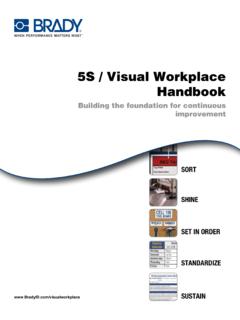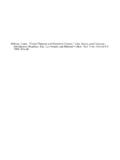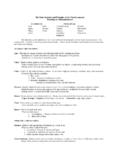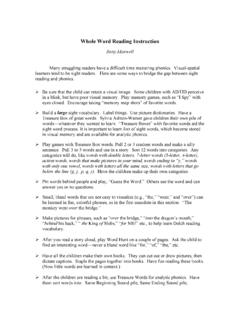Transcription of INTERNATIONAL CODE OF SIGNALS - SeaSources
1 PUB. 102. INTERNATIONAL . code OF SIGNALS . FOR visual , SOUND, AND RADIO COMMUNICATIONS. UNITED STATES EDITION. 1969 Edition (Revised 2003). NATIONAL IMAGERY AND MAPPING AGENCY. PUB. 102. INTERNATIONAL code of SIGNALS As adopted by the Fourth Assembly of the Inter-Governmental Maritime Consultative Organization in 1965. For visual , Sound, and Radio Communications United States Edition, 1969. (Revised 2003). Prepared and published by the NATIONAL IMAGERY AND MAPPING AGENCY. Bethesda, Maryland COPYRIGHT 2003 BY THE UNITED STATES GOVERNMENT. NO COPYRIGHT CLAIMED UNDER TITLE 17 For sale by the Superintendant of Documents, Government Printing Office Internet: Phone: toll free (866) 512-1800; DC area (202) 512-1800. Fax: (202) 512-2250 Mail Stop: SSOP, Washington, DC 20402-0001.
2 PREFACE. Pub 102, the 1969 edition of the INTERNATIONAL code of SIGNALS , became effective on 1 April 1969, and at that time superseded Pubs. 103 and 104, INTERNATIONAL code of SIGNALS , Volumes I and II. All SIGNALS are contained in a single volume suitable for all methods of communication. The First INTERNATIONAL code was drafted in 1855 by a Committee set up by the British Board of Trade. It contained 70,000. SIGNALS using eighteen flags and was published by the British Board of Trade in 1857 in two parts; the first containing universal and INTERNATIONAL SIGNALS and the second British SIGNALS only. The book was adopted by most seafaring nations. This early edition was revised by a Committee set up in 1887 by the British Board of Trade.
3 The Committee's proposals were discussed by the principal maritime powers and at the INTERNATIONAL Conference in Washington in 1889. As a result, many changes were made. The code was completed in 1897 and was distributed to all maritime powers. That edition of the INTERNATIONAL code of SIGNALS , however, did not stand the test of World War I. The INTERNATIONAL Radiotelegraph Conference at Washington in 1927 considered proposals for a new revision of the code and decided that it should be prepared in seven languages, namely in English, French, Italian, German, Japanese, Spanish and in one Scandinavian language which was chosen by the Scandinavian Governments to be the Norwegian language. The new edition was completed in 1930 and was adopted by the INTERNATIONAL Radiotelegraph Conference held in Madrid in 1932.
4 The new code was compiled in two volumes, one for use by visual signaling and the other by radiotelegraphy. Words and phrases applicable to aircraft were introduced in Volume II together with a complete Medical Section and a code for accelerating the granting of pratique. The Medical Section and the pratique SIGNALS were prepared with the assistance and by the advice of the Office INTERNATIONAL d'Hygiene Publique. The code , particularly Volume II, was primarily intended for use by ships and aircraft and, via coastal radio stations, between ships or aircraft and authorities ashore. A certain number of SIGNALS were inserted for communications with shipowners, agents, repair yards, etc. The same Conference (Madrid, 1932) established a Standing Committee to review the code , if and when necessary, to give guidance on questions of use and procedure, and to consider proposals for modifications.
5 Secretarial duties were undertaken by the Government of the United Kingdom. The Standing Committee met only once in 1933 and introduced certain additions and amendments. The Administrative Radio Conference of the INTERNATIONAL Telecommunication Union suggested in 1947 that the INTERNATIONAL code of SIGNALS should fall within the competence of the Inter-Governmental Maritime Consultative Organization (IMCO). In January 1959, the First Assembly of IMCO decided that the Organization should assume all the functions then being performed by the Standing Committee of the INTERNATIONAL code of SIGNALS . The Second Assembly in 1961 endorsed plans for a comprehensive review of the INTERNATIONAL code of SIGNALS intended to meet the present day requirements of mariners.
6 A Subcommittee of the Maritime Safety Committee of the Organization was established to revise the code , to prepare it in nine languages, namely the original seven (English, French, Italian, German, Japanese, Spanish, and Norwegian) together with Russian and Greek, and to consider proposals for a new radiotelephone code and its relation to the INTERNATIONAL code of SIGNALS . The Subcommittee consisted of representatives of the following countries: Argentina, Germany, France, Greece, Italy, Japan, Norway, Russian Federation, United Kingdom, and the United States of America. The following INTERNATIONAL governmental and nongovernmental organizations contributed to, and assisted in, the preparation of the revised code : the INTERNATIONAL Atomic Energy Agency, the INTERNATIONAL Civil Aviation Organization, the INTERNATIONAL Labor Organization, the INTERNATIONAL Telecommunication Union, the World Meteorological Organization, the World Health Organization, the INTERNATIONAL Chamber of Shipping, the INTERNATIONAL Confederation of Free Trade Unions, and the INTERNATIONAL Radio Maritime Committee.
7 The Subcommittee completed the revision of the code in 1964, taking into account Recommendation 42 of the 1960. Conference on Safety of Life at Sea and Recommendation 22 of the Administrative Radio Conference, Geneva 1959. The code was adopted by the Fourth Assembly of IMCO in 1965. The revised code is intended to cater primarily for situations related essentially to safety of navigation and persons, especially when language difficulties arise. It is suitable for transmission by all means of communication, including radiotelephony and radiotelegraphy, thus obviating the necessity for a separate radiotelephone code and dispensing with Volume II for Radiotelegraphy. The revised code embodies the principle that each signal has a complete meaning.
8 It thus leaves out the vocabulary method which was part of the old code . The Geographical Section, not being considered essential, was omitted. By these means it was possible to reduce considerably the volume of the code and achieve simplicity. Changes and corrections for this product will appear in the NIMA weekly Notice to Mariners and must be applied to keep it current. Users should refer information and comments to: MARITIME SAFETY INFORMATION DIVISION, ST D 44, NATIONAL IMAGERY AND MAPPING AGENCY, 4600 SANGAMORE ROAD, BETHESDA MD 20816-5003. iii CONTENTS. PAGE. CHAPTER 1. SIGNALING INSTRUCTIONS ..1. CHAPTER 2. GENERAL signal code ..27. CHAPTER 3. MEDICAL signal code ..105. CHAPTER 4. DISTRESS AND LIFESAVING SIGNALS AND. RADIOTELEPHONE PROCEDURES.
9 137. APPENDIX: Supplementary SIGNALS for Naval Vessels ..151. INDEXES ..153. Index for Signaling Instructions and General signal code ..155. Index for Medical signal code ..159. v CHAPTER 1. CHAPTER 1. SIGNALING INSTRUCTIONS. PAGE. SECTION 1: EXPLANATION AND GENERAL REMARKS ..3. SECTION 2: DEFINITIONS ..4. SECTION 3: METHODS OF SIGNALING ..5. SECTION 4: GENERAL INSTRUCTIONS ..6. SECTION 5: FLAG SIGNALING ..9. SECTION 6: FLASHING LIGHT SIGNALING ..11. SECTION 7: SOUND SIGNALING ..13. SECTION 8: RADIOTELEPHONY ..14. SECTION 9: SIGNALING BY HAND FLAGS OR ARMS ..15. MORSE SIGNALING BY HAND FLAGS OR ARMS ..15. SECTION 10: MORSE SYMBOLS PHONETIC TABLES PROCEDURE SIGNALS ..17. MORSE SYMBOLS ..17. PROCEDURE SIGNALS ..20. SINGLE LETTER SIGNALS .
10 22. SINGLE LETTER SIGNALS WITH COMPLEMENTS ..23. SINGLE LETTER SIGNALS BETWEEN ICEBREAKER AND ASSISTED VESSELS ..24. 1. CHAPTER 1. SECTION 1: EXPLANATION AND GENERAL REMARKS. 1. The purpose of the INTERNATIONAL code of SIGNALS is to provide ways and means of communication in situations related essen- tially to safety of navigation and persons, especially when language difficulties arise. In the preparation of the code , account was taken of the fact that wide application of radiotelephony and radiotelegraphy can provide simple and effective means of communication in plain language whenever language difficulties do not exist. 2. The SIGNALS used consist of: (a) Single-letter SIGNALS allocated to significations which are very urgent, important, or of very common use.





